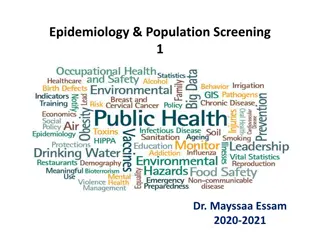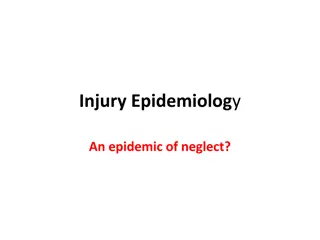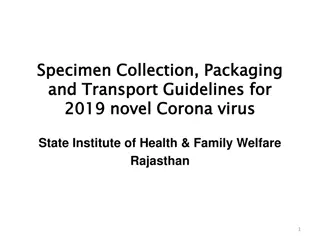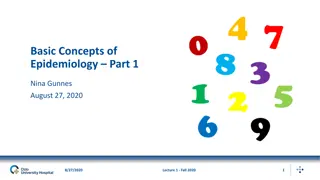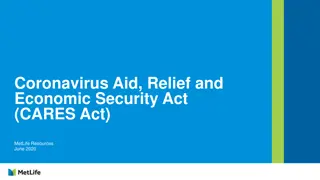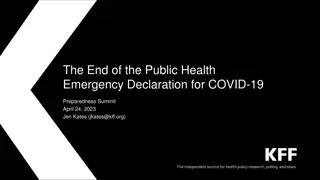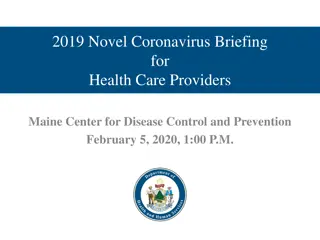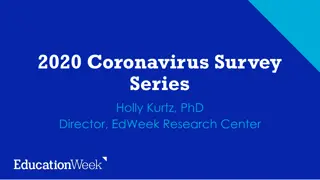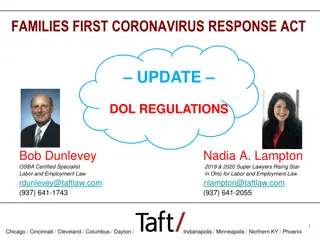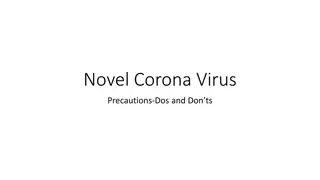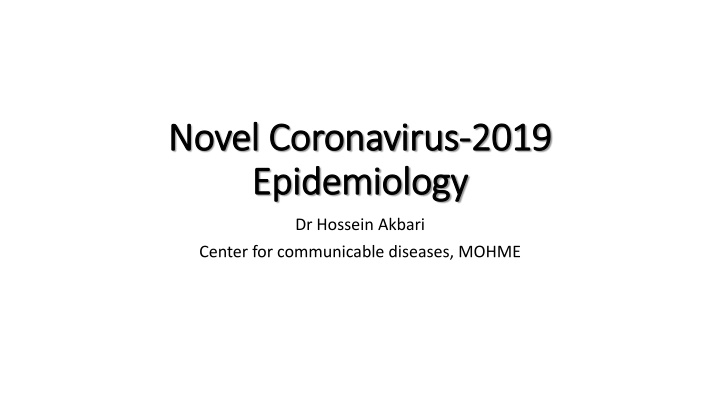
Novel Coronavirus Outbreak: Origins, Epidemiology, and Impact
Uncover the origins and progression of the novel coronavirus outbreak, starting from the initial cases in Wuhan, China. Learn about the epidemiology, response measures, and implications of declaring a Public Health Emergency of International Concern (PHEIC). Explore the characteristics of coronaviruses and their potential sources, shedding light on the global concern surrounding these infectious diseases.
Download Presentation

Please find below an Image/Link to download the presentation.
The content on the website is provided AS IS for your information and personal use only. It may not be sold, licensed, or shared on other websites without obtaining consent from the author. If you encounter any issues during the download, it is possible that the publisher has removed the file from their server.
You are allowed to download the files provided on this website for personal or commercial use, subject to the condition that they are used lawfully. All files are the property of their respective owners.
The content on the website is provided AS IS for your information and personal use only. It may not be sold, licensed, or shared on other websites without obtaining consent from the author.
E N D
Presentation Transcript
Novel Coronavirus Novel Coronavirus- -2019 Epidemiology Epidemiology 2019 Dr Hossein Akbari Center for communicable diseases, MOHME
Event background Event background On 31 December 2019, the Wuhan Municipal Health Commission in Wuhan City, Hubei province, China reported a cluster of 27 pneumonia cases of unknown aetiology, including seven severe cases, with a common reported link to Wuhan's Huanan Seafood Wholesale Market (a wholesale fish and live animal market selling different animal species.
Event background Event background The market was closed to the public on 1 January 2020. According to the Wuhan Municipal Health Commission, samples from the market tested positive for the novel coronavirus. On 9 January 2020, China CDC reported that a novel coronavirus (2019-nCoV) had been detected as the causative agent for 15 of the 59 pneumonia cases. On 10 January 2020, the first novel coronavirus genome sequence was made publicly available. WHO first situation report:
What happens when a PHEIC is declared What happens when a PHEIC is declared? ? When a PHEIC is declared, the Director-General issues temporary recommendations under the IHR (2005), including obligations for countries to provide sufficient public health rationale and justification to WHO about any additional measures beyond what WHO recommends. All countries should be ready to contain any introduction of the virus and its spread through active surveillance, early detection, isolation and case management, contact tracing, and prevention.
The Coronaviruses The Coronaviruses Coronaviruses are enveloped positive stranded RNA viruses. Coronaviruses infect humans and many other vertebrates. Illness in humans is mostly respiratory or gastrointestinal infections. symptoms can range from the common cold to more severe lower respiratory infections such as pneumonia. A broad range of coronaviruses are found in bats, which might play a crucial role in the virus evolution of alpha and betacoronavirus lineages in particular. However, other animal species can also act as an intermediate host and animal reservoir.
Zoonotic coronaviruses have emerged in recent years to cause human outbreaks, such as the Severe Acute Respiratory Syndrome (SARS) in 2003 and the Middle East Respiratory Syndrome (MERS) since 2012.
The Coronaviruses The Coronaviruses To date, seven coronaviruses have been shown to infect humans. Common human coronaviruses Betacoronavirus HCoV-OC43 and HCoV-HKU1 as well as Alphacoronavirus HCoV-229E cause common colds but also severe lower respiratory tract infections in the youngest and oldest age groups while Alphacoronavirus HCoV-NL63 is considered to be an important cause of (pseudo) croup and bronchiolitis in children.
Zoonotic Coronaviruses Zoonotic Coronaviruses Additional zoonotic coronaviruses have emerged and caused outbreaks in humans: SARS-CoV (2002, Betacoronavirus, subgenus Sarbecovirus), MERS-CoV (2012, Betacoronavirus, subgenus Merbecovirus). 2019-nCoV: The 2019-nCoV is closely related to SARS-CoV and genetically clusters within Betacoronavirus subgenus Sarbecovirus
Clinical Clinical features features Human infections with common coronaviruses are mostly mild and asymptomatic, but severe and fatal infections have been observed. the viruses are able to cause more significant lower respiratory tract infections in humans with pneumonia; this is more likely in immunocompromised individuals, people with cardiopulmonary illnesses, as well as the elderly and young children
Clinical features novel coronaviruses Clinical features novel coronaviruses SARS-CoV was identified and caused large outbreaks in 2002 2003; the virus affected 8 096 people causing severe pulmonary infections in different countries globall. MERS-CoV was identified in 2012 in Saudi-Arabia. Clinical presentation following MERS-CoV infection can range from asymptomatic to symptomatic. Symptoms can include fever, cough and shortness of breath, with pneumonia as a common clinical diagnosis. Symptoms can progres in severe cases to acute respiratory distress syndrome (ARDS), septic shock and multi-organ failure resulting in death. In addition, the gastrointestinal tract can be involved with gastrointestinal symptoms, such as diarrhoea. The clinical course is more severe in immunocompromised patients
Demographics, baseline characteristics, and clinical outcomes of 99 patients admitted to Wuhan Jinyintan Hospital (Jan 120, 2020) with 2019- nCoV pneumonia. (Chen N, Zhou M, Dong X, Qu J, Gong F, Han Y, et al. Epidemiological and clinical characteristics of 99 cases of 2019 novel coronavirus pneumonia in Wuhan, China: a descriptive study. The Lancet. 2020.)
Munster VJ, Koopmans M, van Doremalen N, van Riel D, de Wit E. A novel coronavirus emerging in Chinakey questions for impact assessment. New England Journal of Medicine. 2020.
Distribution of laboratory confirmed cases of Distribution of laboratory confirmed cases of 2019 2019- -nCoV worldwide, as of nCoV worldwide, as of 5 5 February February 2020 2020
Geographic distribution of Geographic distribution of 2019 2019- -nCov nCov
Distribution of laboratory confirmed cases of Distribution of laboratory confirmed cases of 2019 by continent (except China), as of by continent (except China), as of 5 5 February 2019- -nCoV nCoV 2020 February 2020
The basic principles to reduce the general risk of transmission of acute respiratory infections include the following: Avoiding close contact with people suffering from acute respiratory infections. Frequent hand-washing, especially after direct contact with ill people or their environment. Avoiding unprotected contact with farm or wild animals. People with symptoms of acute respiratory infection should practice cough etiquette (maintain distance, cover coughs and sneezes with disposable tissues or clothing, and wash hands). Within healthcare facilities, enhance standard infection prevention and control practices in hospitals, especially in emergency departments. WHO does not recommend any specific health measures for travelers.s

